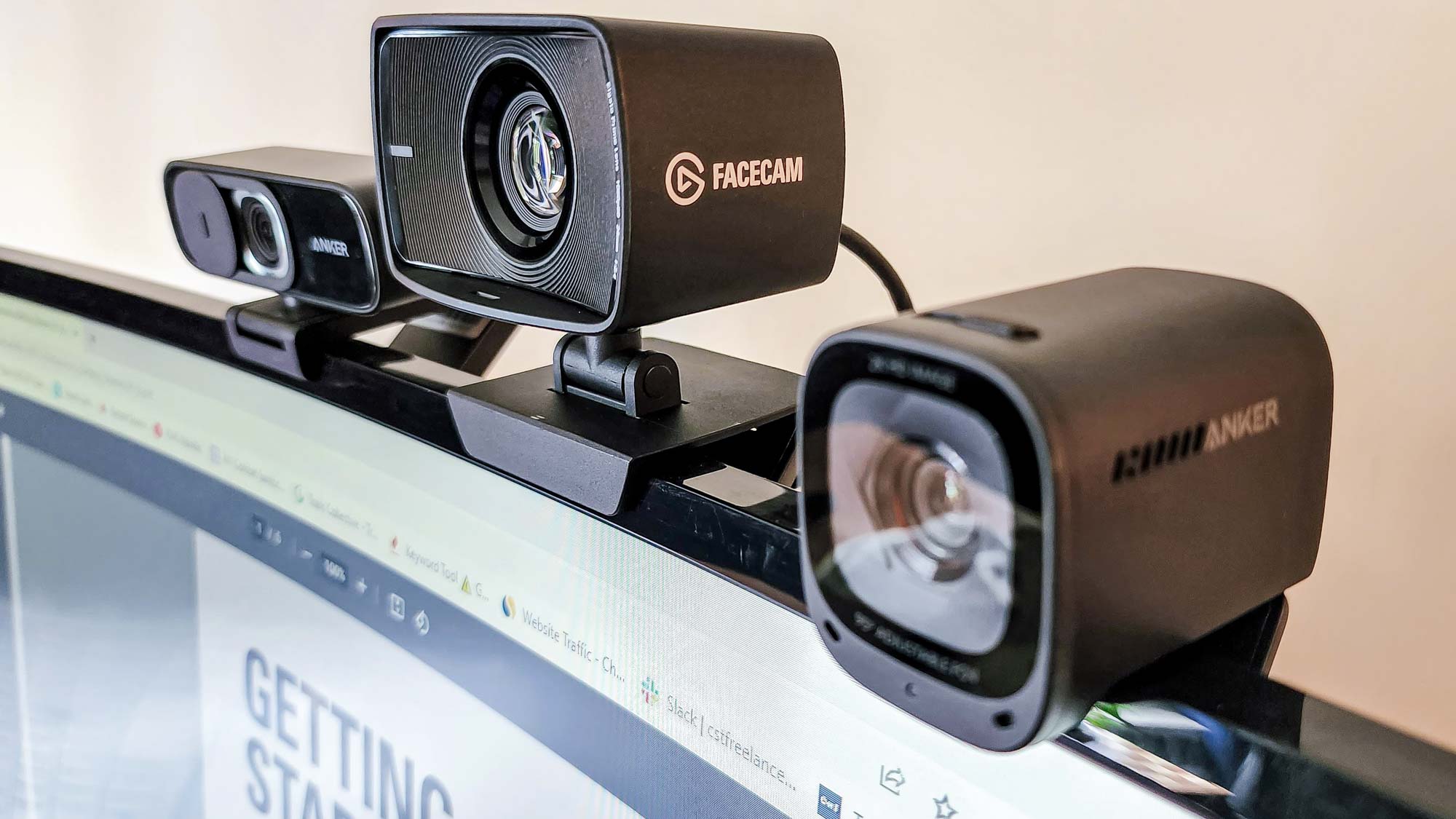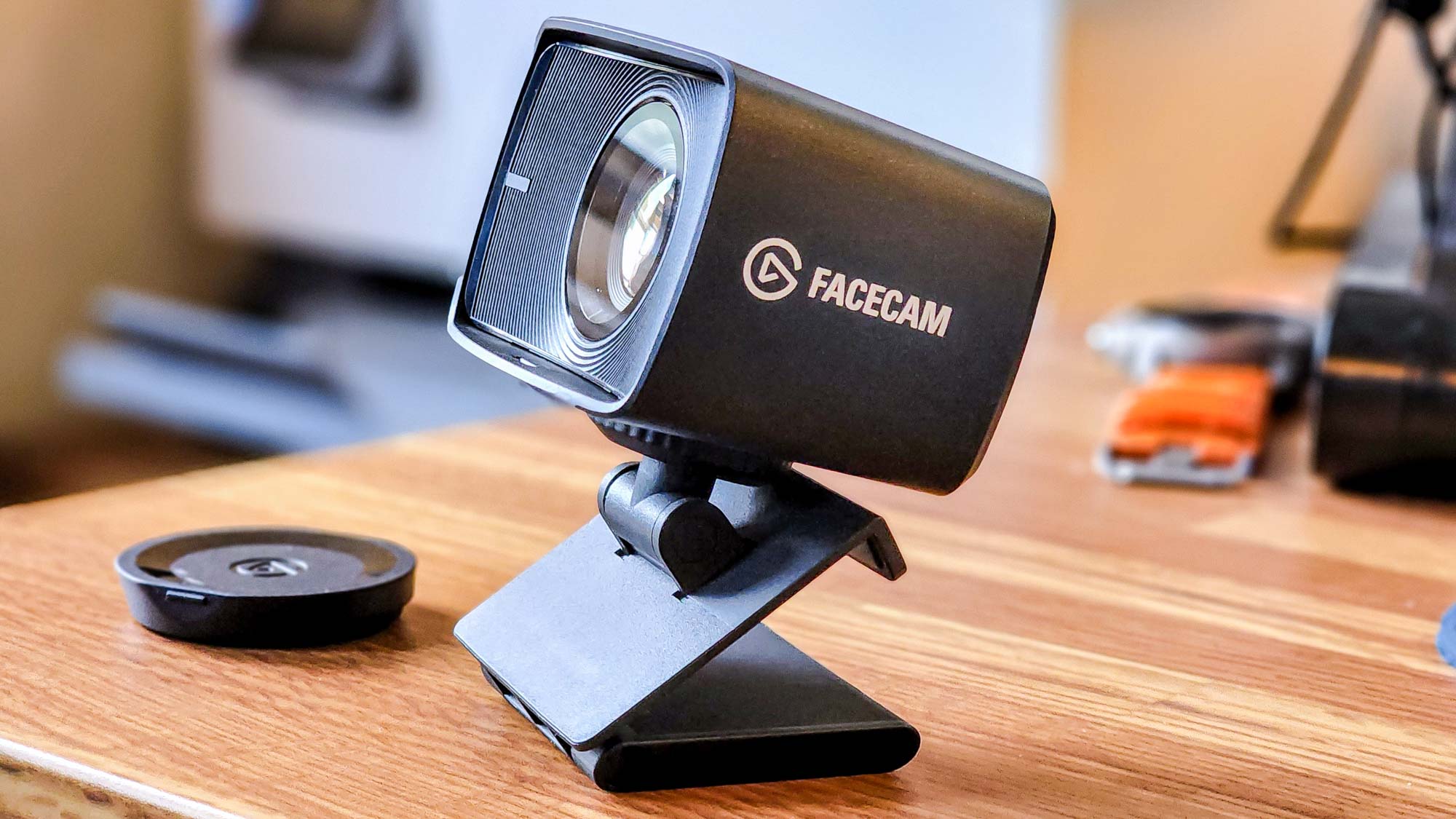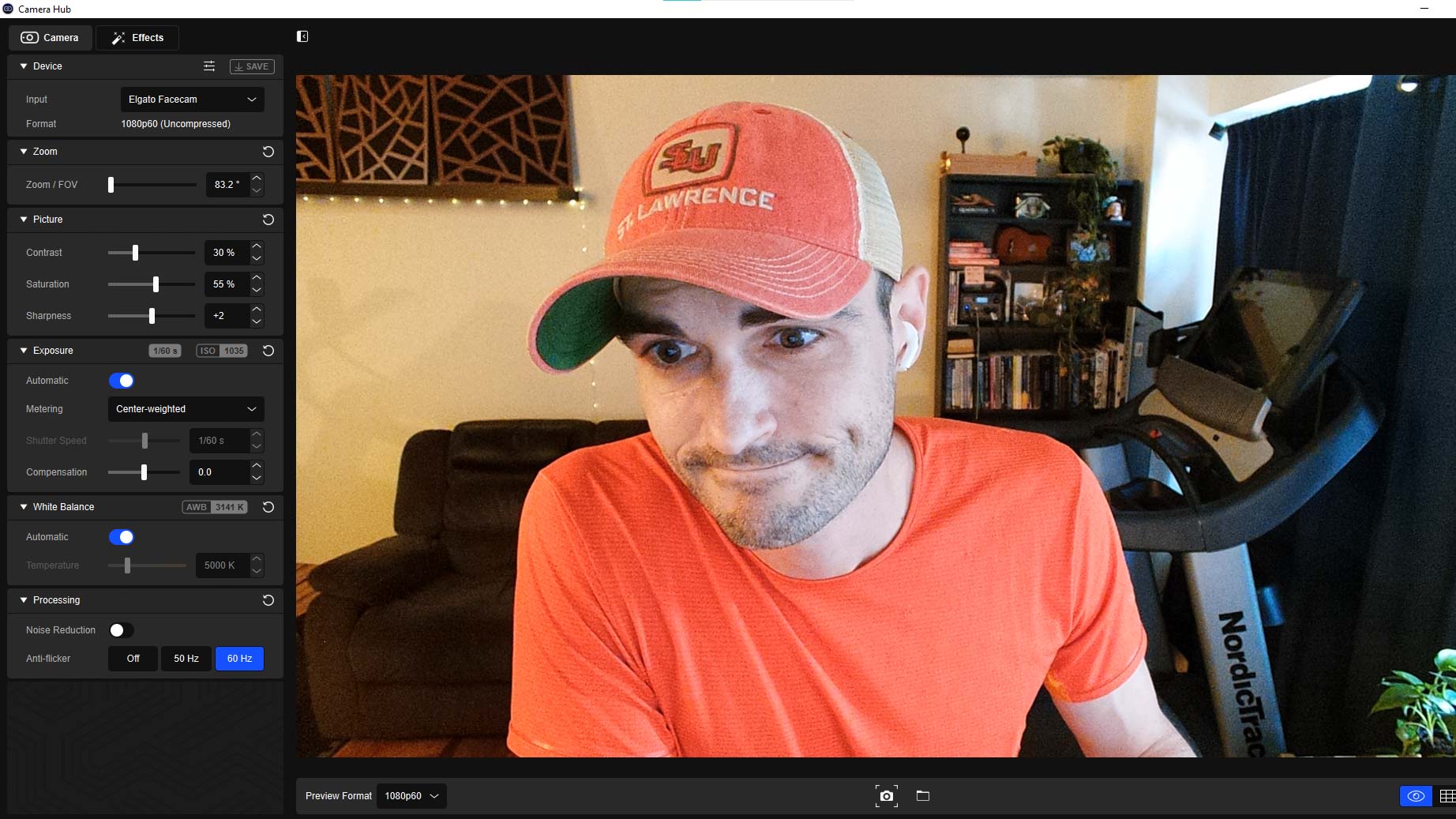Tom's Guide Verdict
If you’re a streamer with deep pockets this 1080p webcam is well worth the investment, and it’s loaded with extra features that make video creation a snap.
Pros
- +
State-of-the-art optics
- +
Swiveling stand design
- +
Dynamic desktop app
- +
Lots of tweakable settings
- +
Plug-and-play usability
- +
Extra-long USB cord included
- +
Excellent low-light performance
- +
Accurate colors and silky smooth frame rates
Cons
- -
Premium price
- -
Bulky for a webcam
- -
Max 1080p resolution
Why you can trust Tom's Guide
OS Support: Windows 10 (64-bit) or later, Mac OS 11 Big Sur or later, mobile app for Android and iOS
Supported Resolution (uncompressed): 1080p at 60/30 fps, 720p at 60/30 fps, 540p at 60/30 fps
Sensor: Sony Starvis CMOS
Diagonal Field of View (FOV) / Digital Zoom: 24.4 to 83.2 degrees
Focus Type / Range: Autofocus (11.8 to 47.2 inches)
Lens Type: Glass
Aperture: f/2.4
Built-in Mic: None
Size: 3.1 x 2.3 x 1.9 inches (without mount)
Weight: 3.4 ounces (without privacy cap and mount)
The Elgato Facecam is looking to breathe new life into the oversaturated market of plug-and-play webcams, and content creators everywhere will appreciate the face-hugging specs under the hood.
Hybrid work environments and high-res web conferencing have become home office mainstays, and the best laptops for video editing keep getting better and better, as do the peripherals we plug into them. Case-in-point: while some webcams focus on ultra-wide viewing angles for the business crowd (and larger groups), Elgato’s Facecam was conversely “crafted for creators,” and it’s touted as “the world's most powerful webcam” on their website. Cue the Hans Zimmer soundtrack in the background as my eyebrows ascend in slow motion.
It’s a bold claim for sure, but the optics speak for themselves: the Facecam was a CES 2022 Innovation Awards honoree, which bodes well for that beautiful Elgato Prime lens thanks to an f/2.4 aperture, 24-millimeter focal length, and a world-class Sony Starvis CMOS.
The whole package is markedly bulkier than your average plug-and-play webcam, but that extra heft has a purpose, and the resulting video is nothing short of fantastic. Whereas action cameras like the GoPro Hero10 Black are made for when you’re on the move, the Facecam is meant for relatively immobile video shot from your laptop or MacBook, and it excels as a home office tool for anyone crafting indoor content on the regular — no matter the lighting conditions.
Is this one of the best webcams you can get your hands on, edging out the excellent Logitech Streamcam and Anker PowerConf C300? Read our full Elgato Facecam review for the full scoop.
Elgato Facecam review: Price, availability and compatibility
As of this writing, the Facecam costs $170 at Elgato’s website. This is the exact same price as the comparably-specced Logitech StreamCam, coincidentally, but $40 more expensive than the Anker PowerConf C300; all three webcams are capable of shooting at 60 frames per second, though at different resolutions.
The Elgato Facecam is refreshingly plug-and-play right out of the box, but its functionality increases tenfold with the accompanying software. You’ll need Windows 10 (64-bit) or Mac OS 11 (Big Sur or later) for the desktop app, and the subscription-based Stream Deck Mobile app works with both iOS and Android. The Facecam is fully compatible with Zoom, Slack, Microsoft Teams, and other video-streaming platforms, allowing you to seamlessly transition between streaming and recording at the drop of a hat.
Get instant access to breaking news, the hottest reviews, great deals and helpful tips.
Elgato Facecam review: DSLR-like design
When placed side-by-side with the Anker PowerConf C200 (which resembles a mini-GoPro), it looks like Elgato sliced a symmetrical chunk out of a full-sized DSLR to create the Facecam, which is a good thing; the more nearby light Elgato’s larger lens has access to, the better picture quality you can expect overall. With such enhanced optics under the hood, however, the Facecam comes with a little extra heft; at 3.1 x 2.3 x 1.9 inches and 3.4 ounces, it’s almost an ounce lighter than the Anker PowerConf C300, and a half-ounce lighter than the PowerConf C200.

The mounting clip made it easy to swivel and tilt the Facecam exactly where I wanted once it was secured to either my laptop display or external monitor. Similar to most webcams in this price range, you’ll find integrated tripod threading on the bottom. The extra-long 6-foot USB cord should be plenty long for most, allowing you to set the Facecam on your desktop if necessary.

Unlike most contemporary webcams, you won’t find any built-in mics flanking the lens — or anything else, for that matter. Uniquely, the Facecam uses your laptop’s mic to capture sound instead, dedicating all of its own inner tech to uncompressed video processing. This removes the necessity of re-encoding video through your laptop as you stream. The end result? Less latency and fewer artifacts. Plus, thanks to the Facecam’s onboard memory, all of your settings are saved on the webcam itself, making it easy to switch between Windows and Mac machines in an instant.

The lens cover snaps off much like it would on a DSLR, which is as much for privacy as it is protection; there’s much more lens to damage during any accidental drops than with smaller, less-powerful webcams like the PowerConf C200. There’s also a blue LED light next to the lens to let you know when the webcam is active.
Facecam review: Video and audio quality
To give the Facecam its fair share of facetime, I used it for several video calls over Zoom, Slack, and Google Meet. I did some of my testing during the day — with plenty of natural sunlight coming in from the window next to me — and at dusk, with much dimmer lighting from my living room lamps. I then compared image quality against the mediocre 720p webcam on my laptop and the recently reviewed Anker PowerConf C300 and C200 during the exact same conditions. Lastly, I compared still photos from each webcam to evaluate overall image quality.
It seems that in order to achieve that smooth-as-silk video quality, Elgato was forced to tighten up the field of view (FOV). Whereas you can toggle between 65, 78, and 95 degrees on the PowerConf C200 and up to a whopping 115 degrees with the PowerConf C300 via the AnkerWork desktop app, the Facecam maxes out at 83.2 degrees. However, the Elgato Camera Hub lets you manually adjust the FOV a few degrees at a time (akin to a DSLR), allowing you to digitally zoom in all the way to 24.4 degrees. This capability alone underlines how the Facecam is best for recording/streaming individuals, as opposed to groups.
(Note: While I have not personally tested the Logitech Streamcam, its 78-degree FOV isn’t adjustable, which is kind of a bummer but hardly a deal-breaker.)
In terms of video performance, colors absolutely popped in all of my live chats, with test callers reporting improved video quality across the board when I toggled between the Anker PowerConf C300/C200 webcams and the Elgato Facecam. The f/2.4 aperture, 24-mm focal length, and Sony Starvis CMOS sensor did an impressive job of enhancing contrast, tonality, and sharpness while minimizing noise and color distortion.

When I tested the Facecam in lower light over Zoom, my friend reported a thin black outline around certain objects (like the text of a book cover), but much smoother video quality overall when compared to Anker. Audio came through crystal-clear on both ends, and my friend couldn’t discern a difference in voice quality whenever I toggled between webcams. Which makes sense, since your Zoom does all the backend audio processing for all three devices, at the end of the day.
Without adjusting the default camera settings at all, the details of my orange shirt and faded red trucker hat came through much better using the Facecam versus the PowerConf C300 and C200, with a speedier autofocus whenever I moved my mug closer to the lens. The lighting also adjusted dynamically as I moved around the room, making the Facecam ideal for just about any shooting environment.
For a more objective perspective, here’s a side-by-side image comparison of the Elgato Facecam, Anker PowerConf C300, PowerConf C200 over Zoom:




Elgato Facecam review: Desktop and smartphone apps
As mentioned above, the Facecam’s Flash memory lets you save your favorite settings right to the webcam itself, making it easy to switch between different laptops without re-tweaking the software each time. And while the Facecam is plug-and-play right out of the box, the Elgato Camera Hub lets you tweak even more settings than you might expect from the average webcam:
- Device – This is where you can change your device input (if you have more than one Elgato cam) and change settings for the LED status light
- Zoom – Toggle the FOV between 83.2 and 24.4 degrees
- Picture – Lets you tweak the contrast, saturation, and sharpness
- Exposure – Choose between automatic or manual exposure, which lets you manage shutter speed and ISO settings
- White Balance – The automatic white balance setting works just fine, but you can manually adjust the color temperature if you like
- Processing – Lets you turn noise reduction on and off, and toggle the anti-flicker between 60 Hz and 50 Hz (for recording under artificial lighting)
- Preview Format – Toggles between 1080p at 60/30 fps, 720p at 60/30 fps, and 540p at 60/30 fps
Overall, Elgato’s software has a similar flavor to Anker and Logitech, but the former software appears to be the most robust when it comes to customization. If you pony up to an additional $3/month or $25/year subscription, the mobile Stream Deck app adds even more functionality to the mix, turning your smartphone into a useful remote.
(Note: If you have an Nvidia GeForce RTX 20-series graphics card or better, you get access to even more special effects in the Camera Hub, such as blurred backgrounds; I didn’t get the chance to test this feature.)
Facecam review: Verdict
Creators rejoice! It may cost more than the average plug-and-play webcam, but the Elgato Facecam is absolutely worth the investment for above-average videos, especially if you’re shooting content on a weekly basis.
Granted, you’ll find many of the same features (along with similar specs) aboard the Logitech Streamcam, but the Facecam feels more like a DSLR that you happen to perch on your laptop. And while you get a much wider FOV with the Anker PowerConf C300, that particular webcam is better suited for the business sector.
Audio and video tech is getting more compact (and affordable!) with every passing year, and the Elgato Facecam is a great example of high-end optics in a tidy package. Thanks to cutting-edge specs, top-tier performance, and a useful software package to boot, this is the webcam to beat.

As a freelance journalist, TJ has over a decade of multi-medium storytelling under his belt. Leveraging a quarter century of collective coddiwompling amid the ever-evolving landscape of wireless gadgetry, his unique editorial background allows him to explore a variety of tech-centric subsectors on this fascinating planet. When he's not field testing new gear in the Catskills, Adirondacks, or an actual field, he can be found sipping Negronis in his living room and crafting Dr. Seussian poetry inside a tattered moleskin.


